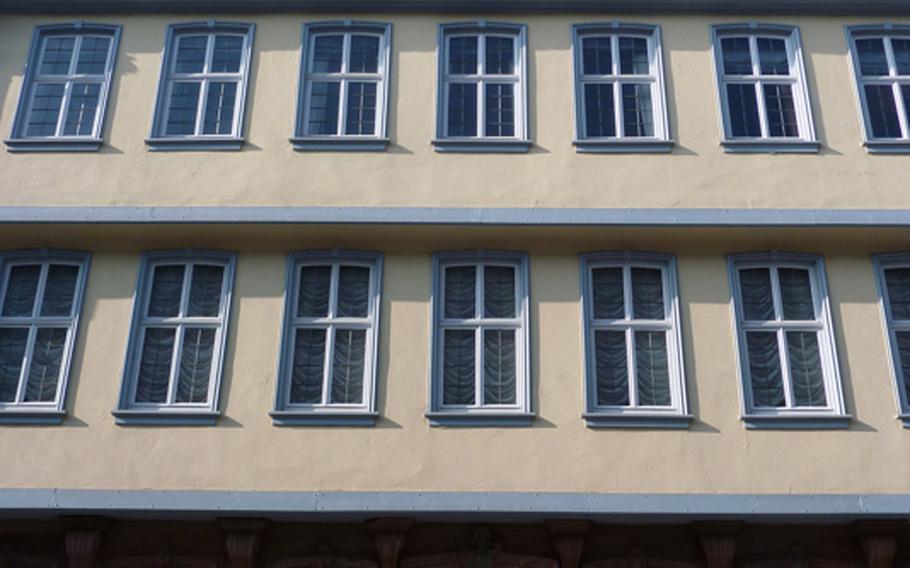
Above: Goethe’s childhood home has four levels to tour. (Michael Abrams/Stars and Stripes)
Johann Wolfgang von Goethe didn’t spend a lot of time in Frankfurt. He lived in Leipzig, Strasbourg, Rome and Weimar, where he died.
But it was in this big house on Hirschgraben, in the free imperial city of Frankfurt, where — according to legend, at the stroke of 12 noon — the German literary giant was born on Aug. 28, 1749.
He grew up here before heading to Leipzig to study. After returning, he got his literary start here before heading out into the big, wide world.
The Goethe family itself has a longer history in Frankfurt. Goethe’s grandmother Cornelia bought two neighboring half-timbered houses in the city in 1733. His parents, Johann Casper and Catharina Elizabeth, were living here when Johann Wolfgang was born in 1749, followed by his sister, Cornelia, a year later.
Five years later Johann Casper had the two houses rebuilt into one spacious house. It is this house that you can visit today. Actually, it’s the reconstructed house, as the original building was destroyed by Allied bombing in World War II.
There are four floors of rooms to see, labeled German-style: ground floor, first, second, third. Each has its own highlights. Most have more to do with the father’s collecting habits than with the son’s literature.
On the ground floor, check out the original water pump that was connected to a cellar well. In the Yellow Room, you can view the bust of a young Goethe and a painting of him holding a silhouette.
The first floor is dominated by the Peking Room, which was used for parties and important visits but not for day-to-day life. It gets its name from the China-inspired wallpaper.
In the hall, note the elder Goethe’s copper engravings of Rome. It is thought that they inspired his son to travel to the Eternal City.
The Goethes were a musical family, and the real highlight of this floor is the rare vertical pianoforte, known as a pyramid piano, in the Music Room.
A floor up is another of the house’s highlights, the 18th-century astronomical clock. It shows date and time, the phase of the moon and the sun’s position in the zodiac. And when the little dancing bear in the clock’s small window falls down, it is time to wind the clock up.
In a rather small, plain room on this floor is where it is believed Johann Wolfgang first saw the light of day.
On this story you will also find his mother’s room, the art gallery, his father’s library and the room Cornelia occupied before she married.
If the ghost of Goethe can be felt in the house, it is in the third floor Writing Room. Here the young writer composed poems, plays, an early version of “Faust” and the novel “The Sorrows of Young Werther,” mostly at the stand-up desk. The room is decorated with his drawings.
In the next room is a puppet theater given to Goethe when he was 4. It pops up in his novel “Wilhelm Meister’s Theatrical Mission.”
During the Seven Years’ War in the mid-18th century, French governor Count Thoranc was billeted in the Goethes’ house. While here, he had local artists paint for him in the room under the house’s mansard. The highlight is Johann Georg Trautmann’s “Joseph Cycle” paintings, telling the story of Joseph from the Old Testament.
On the QTDIRECTIONSThe Goethe-Haus is in downtown Frankfurt at Grosser Hirschgraben 23-25 between Hauptwache and Berlinerstrasse. There is no free parking nearby, so it is best to park in a parking garage. Hauptwache, Goetheplatz and Dom parking garages are within walking distance, and there are signs marked Goethe-Haus. The Hauptwache S-Bahn/U-Bahn stop that serves many lines is about a five-minute walk.
TIMESThe house is open 10 a.m. to 5 p.m. Monday to Saturday, and 10 a.m. to 5:30 p.m. Sundays and German holidays. It is closed on Good Friday, Christmas Eve, Christmas, New Year’s Eve and New Year’s Day.
COSTSAdults 5 euros, students 2.50 euros and children 1.50 euros. A family ticket (with maximum of two adults) costs 8 euros.
FOODThere is no place to eat in the museum, but the Goethe-Haus is surrounded by restaurants and cafes.
INFORMATIONThe website www.goethehaus-frankfurt.de has an English-language version and a floor-by-floor design of the house. At the same location, the Goethe-Museum, which features art from Goethe’s time, is closed for renovations until May.